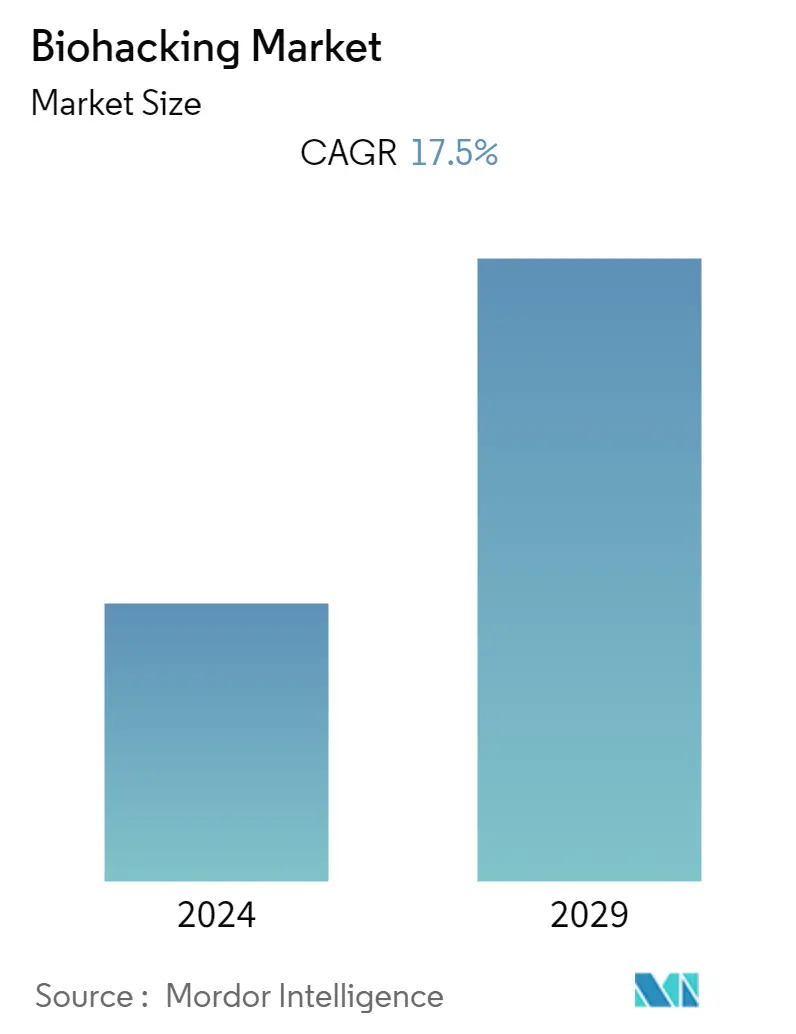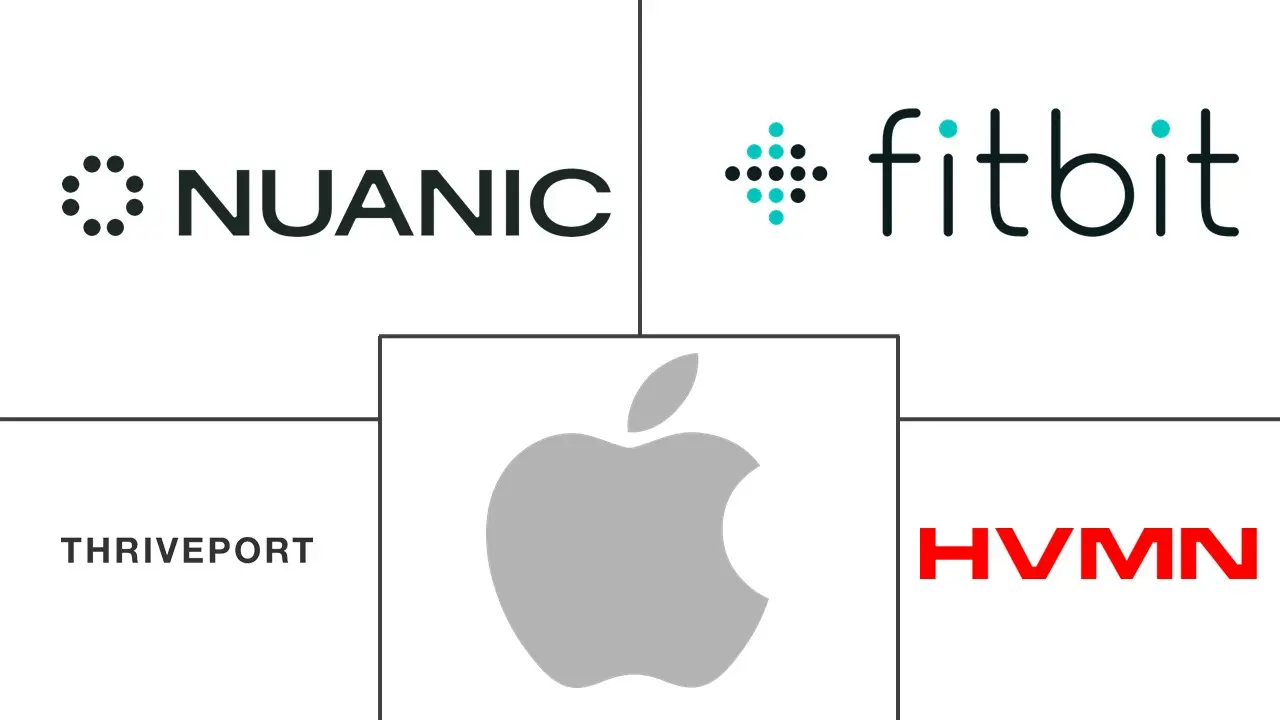Market Size of Biohacking Industry

| Study Period | 2019 - 2029 |
| Base Year For Estimation | 2023 |
| CAGR | 17.50 % |
| Fastest Growing Market | Asia Pacific |
| Largest Market | North America |
| Market Concentration | Medium |
Major Players
*Disclaimer: Major Players sorted in no particular order |
Biohacking Market Analysis
The Biohacking Market studied is anticipated to grow at a CAGR of 17.5% during the forecast period.
During the initial phase of the COVID-19 pandemic, the market experienced significant growth, as the negative impact of COVID-19 was very negligible. For instance, in March 2020, during the initial phase, there was a coalition formed, namely Just One Giant Lab (JOGL), to develop solutions to the myriad challenges posed by the coronavirus. Since then, the group has seen a record number of engagement on its platforms, it says, with 380 members from every continent on the planet except Antarctica working together to develop coronavirus tools. Thus, such initiatives have reduced the adverse impact of COVID-19 during the initial phase. Furthermore, initiatives by key market players, such as product launches, are expected to increase market growth. For instance, in July 2021, Scientists at the University of Texas at Dallas developed a wearable sweat sensor that can monitor the body's immune response to COVID-19 and other infections.
Similarly, various smartphone companies have launched bands/watches with optical sensors to monitor SpO2 levels in the blood. Optical SpO2 sensors use red and infrared light sensors to detect your oxygen levels, sensing changes in those levels by looking at the color of the blood. For instance, in January 2021, Oneplus launched the OnePlus Band equipped with a SpO2 blood-oxygen saturation monitor with an optical sensor that monitors the sleep, heart rate, and fitness of the user. Thus, such product launches are expected to increase the adoption of this technology and further increase the market growth.
Various factors have affected the market growth, such as advancements in healthcare technology, increasing focus on preventive healthcare, and the rising demand for personalized medicine. Advancements in technology within the biohacking market are benefiting from the miniaturization of medical sensors and their integration with biohacking devices. These sensors, which respond to physical stimuli such as sound, pressure, heat, light, and motion, offer detailed sensing techniques for diagnosing, monitoring, imaging, and treating diseases. The miniaturization of sensors enables seamless integration with biohacking devices, allowing for continuous and real-time monitoring of physiological parameters. This integration enhances biohackers' ability to collect accurate and personalized data, providing insights for optimizing performance, managing stress, and achieving health goals.
Similarly, the acquisition is another factor in market growth as it increases the investment in upcoming advanced sensor technology invented by the startups. For instance, in November 2022, CardieX Limited acquired Blumio, Inc., a Silicon Valley-based developer of advanced algorithms and technology for cardiovascular sensors, signifying the company's continued investment in cardiovascular health monitoring technologies. Blumio's technology has the potential to significantly increase clinical performance for CardieX's ecosystem of heart health monitoring solutions.
Personalized medicine aims to tailor medical treatments and interventions to individual patients based on their unique genetic makeup, lifestyle factors, and health characteristics. For instance, in February 2022, SEngine Precision Medicine Inc., and Oncodesign entered into a research collaboration agreement for the R&D of a new personalized cancer treatment to evaluate the feasibility to convert the already identified Nanocyclix inhibitor series into drug candidates that are likely to be effective in the clinic. Biohacking techniques, tools, and communities can contribute to the development and adoption of personalized medicine by enabling individualized health monitoring, genetic analysis, self-optimization, collaboration, and consumer empowerment. Thus, the increasing advancement in technology and demand for personalized medicine is expected to increase market growth over the forecast period.
However, the ethical and regulatory concerns coupled with the data privacy and security risks are expected to hinder market growth.
Biohacking Industry Segmentation
As per the scope, biohacking or body hacking is the practice of putting RFID chip implants, sensors, magnets, and other tech implants under the skin. The Biohacking Market is segmented by Products (Genetic Engineering and Gene Editing Tools, DIY Biology Kits and Biohacking Accessories, Implantable Devices and Wearables, Cognitive Enhancement and Nootropics, and Others), Applications (Medical Diagnostics and Monitoring, Biohacking for Personalized Treatment Plans, Cognitive Enhancement for Mental Performance, Genetic Editing for Personalized Gene Therapies, and Others), End Users (Pharmaceutical and Biotechnology Companies, Research Institutes and Academic Centers, Hospitals and Healthcare Facilities, and Others), and Geography (North America, Europe, Asia-Pacific, Middle East and Africa, and South America). he market report also covers the estimated market sizes and trends for 17 different countries across major regions, globally. The report offers the value (in USD million) for the above segments.
| By Products | |
| Genetic Engineering and Gene Editing Tools | |
| DIY Biology Kits and Biohacking Accessories | |
| Implantable Devices and Wearables | |
| Cognitive Enhancement and Nootropics | |
| Others |
| By Applications | |
| Medical Diagnostics and Monitoring | |
| Biohacking for Personalized Treatment Plans | |
| Cognitive Enhancement for Mental Performance | |
| Genetic Editing for Personalized Gene Therapies | |
| Others |
| By End Users | |
| Pharmaceutical and Biotechnology Companies | |
| Research Institutes and Academic Centers | |
| Hospitals and Healthcare Facilities | |
| Others |
| Geography | ||||||||
| ||||||||
| ||||||||
| ||||||||
| ||||||||
|
Biohacking Market Size Summary
The biohacking market is poised for significant expansion, driven by advancements in healthcare technology and a growing emphasis on preventive and personalized medicine. The integration of miniaturized medical sensors with biohacking devices has enabled real-time monitoring of physiological parameters, enhancing the ability to collect personalized data for optimizing health and performance. This technological progress, coupled with increased investment in advanced sensor technologies through acquisitions, is expected to propel market growth. Initiatives by key players, such as product launches and collaborations in personalized medicine, further contribute to the market's expansion. However, ethical, regulatory, and data privacy concerns may pose challenges to this growth trajectory.
The market's growth is also supported by the rising prevalence of chronic diseases, which drives the demand for health sensor technology and wearable devices. The North American region, in particular, is expected to see substantial growth due to the high incidence of chronic conditions like Alzheimer's and cardiovascular diseases. Product approvals and clinical trials in this region highlight the increasing adoption of biohacking solutions. The market is moderately fragmented, with key players like Apple Inc., Fitbit, Inc., and others playing significant roles. These companies are actively involved in strategic initiatives, such as acquisitions and product launches, to strengthen their market positions and drive further growth.
Biohacking Market Size - Table of Contents
-
1. MARKET DYNAMICS
-
1.1 Market Overview
-
1.2 Market Drivers
-
1.2.1 Advancements in Healthcare Technology
-
1.2.2 Increasing Focus on Preventive Healthcare
-
1.2.3 Rising Demand for Personalized Medicine
-
-
1.3 Market Restraints
-
1.3.1 Ethical and Regulatory Concerns
-
1.3.2 Data Privacy and Security Risks
-
-
1.4 Porter's Five Forces Analysis
-
1.4.1 Threat of New Entrants
-
1.4.2 Bargaining Power of Buyers/Consumers
-
1.4.3 Bargaining Power of Suppliers
-
1.4.4 Threat of Substitute Products
-
1.4.5 Intensity of Competitive Rivalry
-
-
-
2. MARKET SEGMENTATION (Market Size by Value - USD Million)
-
2.1 By Products
-
2.1.1 Genetic Engineering and Gene Editing Tools
-
2.1.2 DIY Biology Kits and Biohacking Accessories
-
2.1.3 Implantable Devices and Wearables
-
2.1.4 Cognitive Enhancement and Nootropics
-
2.1.5 Others
-
-
2.2 By Applications
-
2.2.1 Medical Diagnostics and Monitoring
-
2.2.2 Biohacking for Personalized Treatment Plans
-
2.2.3 Cognitive Enhancement for Mental Performance
-
2.2.4 Genetic Editing for Personalized Gene Therapies
-
2.2.5 Others
-
-
2.3 By End Users
-
2.3.1 Pharmaceutical and Biotechnology Companies
-
2.3.2 Research Institutes and Academic Centers
-
2.3.3 Hospitals and Healthcare Facilities
-
2.3.4 Others
-
-
2.4 Geography
-
2.4.1 North America
-
2.4.1.1 United States
-
2.4.1.2 Canada
-
2.4.1.3 Mexico
-
-
2.4.2 Europe
-
2.4.2.1 Germany
-
2.4.2.2 United Kingdom
-
2.4.2.3 France
-
2.4.2.4 Italy
-
2.4.2.5 Spain
-
2.4.2.6 Rest of Europe
-
-
2.4.3 Asia-Pacific
-
2.4.3.1 China
-
2.4.3.2 Japan
-
2.4.3.3 India
-
2.4.3.4 Australia
-
2.4.3.5 South Korea
-
2.4.3.6 Rest of Asia-Pacific
-
-
2.4.4 Middle East and Africa
-
2.4.4.1 GCC
-
2.4.4.2 South Africa
-
2.4.4.3 Rest of Middle East and Africa
-
-
2.4.5 South America
-
2.4.5.1 Brazil
-
2.4.5.2 Argentina
-
2.4.5.3 Rest of South America
-
-
-
Biohacking Market Size FAQs
What is the current Biohacking Market size?
The Biohacking Market is projected to register a CAGR of 17.5% during the forecast period (2024-2029)
Who are the key players in Biohacking Market?
Apple Inc., Fitbit, Inc., Nuanic, Health Via Modern Nutrition Inc and Thriveport, LLC are the major companies operating in the Biohacking Market.

